
Albrecht Gessler, also known as Hermann, [1] was a legendary 14th-century Habsburg bailiff (German : Landvogt) at Altdorf, [2] whose brutal rule led to the William Tell rebellion and the eventual independence of the Old Swiss Confederacy. [3] [4]

Albrecht Gessler, also known as Hermann, [1] was a legendary 14th-century Habsburg bailiff (German : Landvogt) at Altdorf, [2] whose brutal rule led to the William Tell rebellion and the eventual independence of the Old Swiss Confederacy. [3] [4]
According to the Chronicon Helveticum by Aegidius Tschudi (1505–1572), in 1307 Gessler raised a pole in the market square of Altdorf, Uri, Switzerland, placed his hat atop it, and ordered all the townsfolk to bow before it. Tell, whose marksmanship and pride were legendary, publicly refused. Gessler's cruel wrath was tempered by his curiosity to test Tell's skill, so he gave Tell the option of either being executed or shooting an apple off his son's head in one try. Tell succeeded in splitting the apple with his arrow, saving his own life. When Gessler asked why he had readied two crossbow bolts, he lied and replied that it was out of habit. After being assured that he would not be killed, Tell finally admitted that the second was intended for the tyrant if his son was harmed.
Gessler, enraged, had Tell arrested and taken by boat across Lake Lucerne to Küssnacht to spend the life he had saved in a dungeon. A sudden fierce storm made the crew terrified and, since William Tell was a better sailor, they handed the wheel to him but, instead of heading towards the dungeon, he escaped to shore. There he ambushed and killed Gessler with an arrow, launching the young Confederacy's rebellion against Austrian rule.

A Gessler family of ministeriales is documented from the 13th century onwards but at Wiggwil in the Aargau region, the original homeland of the Habsburgs and the basis for their rise after the extinction of the Swabian House of Hohenstaufen. The Gesslers profited from the election of Count Rudolph of Habsburg as King of the Romans in 1273 and his acquisition of the Austrian and Styrian duchies after the victory over King Ottokar II of Bohemia at the 1278 Battle on the Marchfeld.
The White Book of Sarnen , written around 1470, mentioned one gesler who was vogt at Uri and Schwyz. In the late 14th century one Hermann Gessler ruled the domain of Grüningen (which today belongs to Zürich); the domain of Grüningen had been pawned to the Gessler family by the House of Habsburg. [5] His stern measures against the peasant population made the name Gessler an epitome of tyranny.
No sources that predate the earliest references to the Tell legend of the late 15th century refer to a bailiff Gessler in central Switzerland, and it is presumed that no such person existed. Gessler's role in Tell's story is analogous to that of King Niðung in the story of Egil in the Þiðrekssaga .
Friedrich Schiller perpetuated the figure in his 1804 drama Wilhelm Tell . In the Tale Spinners For Children recording of the story, Gessler is working under orders from the Emperor of Austria, who wishes to deliberately provoke the people of Switzerland into a rebellion which will serve as an excuse for Austria to invade Switzerland.

The canton of Uri is one of the 26 cantons of Switzerland and a founding member of the Swiss Confederation. It is located in Central Switzerland. The canton's territory covers the valley of the Reuss between the St. Gotthard Pass and Lake Lucerne.
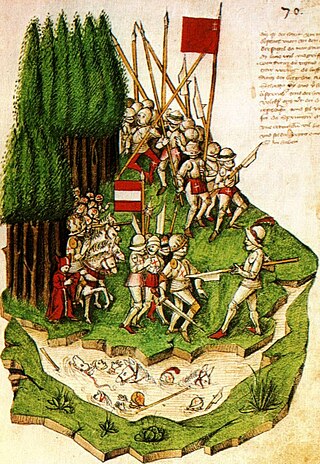
The Battle of Morgarten took place on 15 November 1315, when troops of Schwyz, supported by their allies of Uri and Unterwalden, ambushed an Austrian army under the command of Leopold I, Duke of Austria on the shores of Lake Ägeri, in the territory of Schwyz.

Altdorf is a municipality in Switzerland. It is the capital of the Swiss canton of Uri and retains historic town privileges. It is the place where, according to the legend, William Tell shot the apple from his son's head.

William Tell is a French-language opera in four acts by Italian composer Gioachino Rossini to a libretto by Victor-Joseph Étienne de Jouy and L. F. Bis, based on Friedrich Schiller's play Wilhelm Tell, which, in turn, drew on the William Tell legend. The opera was Rossini's last, although he lived for nearly 40 more years. Fabio Luisi said that Rossini planned for Guillaume Tell to be his last opera even as he composed it. The often-performed overture in four sections features a depiction of a storm and a vivacious finale, the "March of the Swiss Soldiers".
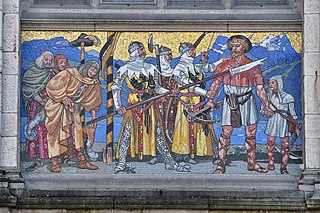
William Tell is a fictional folk hero of Switzerland. According to the legend, Tell was an expert mountain climber and marksman with a crossbow who assassinated Albrecht Gessler, a tyrannical reeve of the Austrian dukes of the House of Habsburg positioned in Altdorf, in the canton of Uri. Tell's defiance and tyrannicide encouraged the population to open rebellion and to make a pact against the foreign rulers with neighbouring Schwyz and Unterwalden, marking the foundation of the Swiss Confederacy. Tell was considered the father of the Swiss Confederacy.
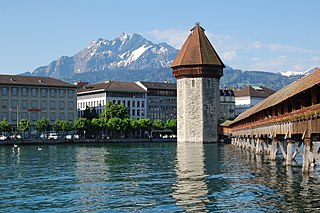
The Reuss is a river in Switzerland. With a length of 164 kilometres (102 mi) and a drainage basin of 3,426 square kilometres (1,323 sq mi), it is the fourth largest river in Switzerland. The upper Reuss forms the main valley of the canton of Uri. The course of the lower Reuss runs from Lake Lucerne to the confluence with the Aare at Brugg and Windisch.

The Old Swiss Confederacy began as a late medieval alliance between the communities of the valleys in the Central Alps, at the time part of the Holy Roman Empire, to facilitate the management of common interests such as free trade and to ensure the peace along the important trade routes through the mountains. The Hohenstaufen emperors had granted these valleys reichsfrei status in the early 13th century. As reichsfrei regions, the cantons of Uri, Schwyz, and Unterwalden were under the direct authority of the emperor without any intermediate liege lords and thus were largely autonomous.

Further Austria, Outer Austria or Anterior Austria was the collective name for the early possessions of the House of Habsburg in the former Swabian stem duchy of south-western Germany, including territories in the Alsace region west of the Rhine and in Vorarlberg.
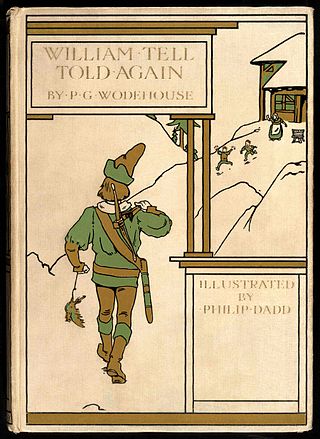
William Tell Told Again is a retelling of the William Tell legend in prose and verse with illustrations. The main prose element was written by P. G. Wodehouse, while Philip Dadd supplied the frontispiece and 15 full-page illustrations, all in colour. The 15 illustrations were each accompanied by a verse written by John W. Houghton, who also wrote the prologue and epilogue in verse.
Gessler or Geßler is a German surname. Notable people with the surname include:
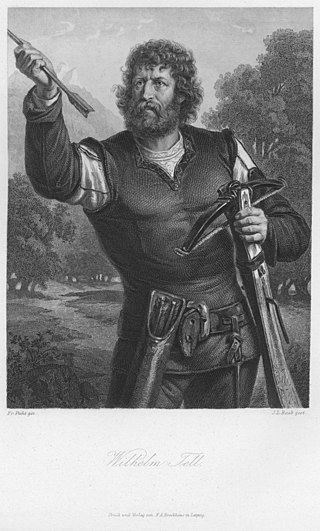
William Tell is a drama written by Friedrich Schiller in 1804. The story focuses on the legendary Swiss marksman William Tell as part of the greater Swiss struggle for independence from the Habsburg Empire in the early 14th century. Gioachino Rossini's four-act opera Guillaume Tell was written to a French adaptation of Schiller's play.

Crossbow is a 1987 historical drama action adventure television series that aired on CBN Cable Network. The series was produced by Steven North and Richard Schlesinger for Robert Halmi Inc., in co-production with French television network FR3, and filmed entirely on location in France.
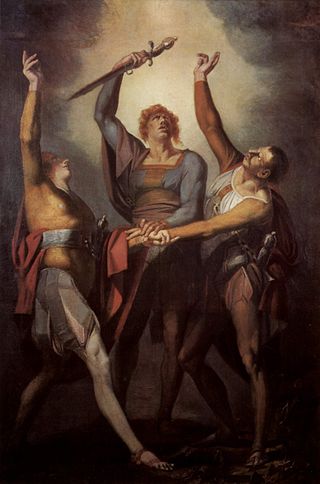
The Rütli Oath is the legendary oath taken at the foundation of the Old Swiss Confederacy by the representatives of the three founding cantons, Uri, Schwyz and Unterwalden. It is named after the site of the oath taking, the Rütli, a meadow above Lake Uri near Seelisberg. Recorded in Swiss historiography from the 15th century, the oath is notably featured in the 19th century play William Tell by Friedrich Schiller.

Grüningen is a town and municipality in the district of Hinwil in the canton of Zürich in Switzerland, notable for its well-preserved historic nucleus.

The 'Tell Monument' is a memorial to William Tell in the market place of Altdorf, Canton of Uri, Switzerland.
The Bundeslied or Tellenlied is a patriotic song of the Old Swiss Confederacy. Its original composition dates to the Burgundian Wars period (1470s). The oldest extant manuscript text was written in 1501, the first publication in print dates to 1545. It consists of stanzas of six lines each, with a rhyming scheme of A-A-B-C-C-B. It is one of the oldest existing records of the legend of Swiss national hero William Tell.
The Chronicle of the City of Lucerne is the oldest existing chronological account of the history of the city of Lucerne.

William Tell is a 1923 German silent adventure film directed by Rudolf Dworsky and Rudolf Walther-Fein and starring Hans Marr, Conrad Veidt, and Erich Kaiser-Titz. The film portrays the story of the legendary Swiss national hero William Tell. The sets were designed by Rudi Feld. It premiered at the Marmorhaus in Berlin.
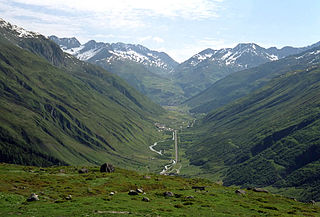
Uri is a Swiss Talschaft and canton in the upper Reuss valley.

The Stauffacherin is a Swiss legendary figure. According to Swiss folklore, she was the wife of Werner Stauffacher, the Landammann of the Canton of Schwyz and a founding father of the Old Swiss Confederacy. She was depicted in Friedrich Schiller's 1804 play William Tell as an advisor to her husband, advocating for Swiss independence from Habsburg rule. The image of the Stauffacherin, often viewed as the feminine counterpart to Wilhelm Tell, has become a symbol for Swiss national pride, spiritual national defence, democracy, and women's suffrage.
{{cite web}}: |last= has generic name (help)